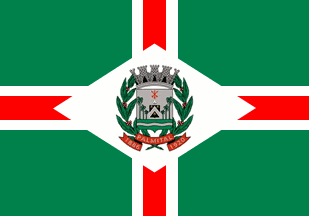 image by Dirk Schönberger,
20 December 2012
image by Dirk Schönberger,
20 December 2012Based on: http://www.palmital.sp.gov.br/simbolos.php

Last modified: 2012-12-29 by ian macdonald
Keywords: sao paulo | palmital |
Links: FOTW homepage |
search |
disclaimer and copyright |
write us |
mirrors
 image by Dirk Schönberger,
20 December 2012
image by Dirk Schönberger,
20 December 2012
Based on:
http://www.palmital.sp.gov.br/simbolos.php
A green flag with a red upright centred cross, bordered white, with the municipal arms in the centre on a white lozenge.
Official website at
http://www.palmital.sp.gov.br
Dirk Schönberger,
20 December 2012
Palmital was founded on 20 January 1886 by João Batista de Oliveira Aranha and his sons, from São Manoel; the early settlement, named Água do Aranha, was located 4 km from the today's town. Other colonists from São Manoel subsequently established new settlements: Manoel José Batista in Água da Fartura (1891), Joaquim Silvério da Cruz in Água Clara (1898), and Salvador Ricci in Água das Anhumas (1898). They were joined in 1910 by Júlio d’Oliveira Castanha and Licério Nazareth de Azevedo, from Campos Novos Paulista, who built a hotel, and Elias Chedid, who built a store. The owner of the land, Severino Francisco da Costa, split it into several plots to boost colonization. The inauguration in 1913 of a railway post, subsequently a station, by the Sorocabana Railway Company, boosted even more the development of Palmital. The municipality of Palmital was established on 21 April 1920.
The symbols of Palmital, designed by Arcinoé Antônio Peixoto de Faria, are prescribed by Municipal Law No. 981 of 7 June 1974.
The flag is green, quartered by a red cross fimbriated in white. In the middle of the flag is placed a white lozenge charged with the municipal coat of arms.
The cross symbolizes the Christian feelings of the inhabitants. The coat of arms represents the municipal government, while the lozenge represents the town as the seat of the municipality. The arms of the cross represent the municipal power spreading all over the municipal territory. THe green quarters represent the rural estates located on the municipal territory. Green is a symbol of honour, civility, courtesy, joy and abundance. Red is a symbol of dedication, patriotic love, audacity, intrepidity, courage and valiance. White is a symbol of peace, friendship, work, prosperity, purity and religious feeling.
Photo of the flag:
http://jcconcursos.bol.uol.com.br/Concursos/Noticiario/edital-concurso-palmital-prefeitura-51-sp-43203
The coat of arms is "Argent an escutcheon of the Aranha family ensigned by three arrows gules surrounded by six palms vert the base of the same a fess wavy argent. The shield surmounted by an eight- towered mural crown argent ports gules. The shield supported by branches of coffee fructed proper. Below the shield a scroll gules inscribed "1886 - PALMITAL - 1920" in letters argent."
The Samnitic shield was the first style of shield in Portuguese
heraldry, introduced from France.
The eight-towered mural crown is the symbol of a second-rank town,
seat of a "comarca".
The palm trees ("palmeiras") recall the municipality's namesake.
The fess wavy argent represents river Paranapanema.
The escutcheon recalls the pioneer João Batista de Oliveira Aranha,
who settled in Palmital in 1886.
The arrows recall St. Sebastian, the town's patron saint.
Coffee is the main product of the fertile and generous soil.
The dates "1886" and "1920" recall the foundation and political
emancipation of Palmital, respectively.
Ivan Sache, 21 December 2012